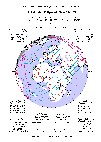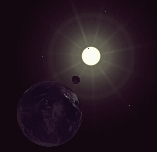|
- - text and links as of last publication / le texte et les liens en l'état lors de la dernière publication- - March 29th, 2006 Total Solar Eclipse
This first solar eclipse of 2006 is a total eclipse. A total eclipse occurs when, for a given place or path at Earth, it's this part of the Moon's shadows called the "umbra" which is falling there. The apparent diameter of the Moon being larger than the Sun's, the latter is seen totally occulted by the Moon. The onlookers will be granted by the famed great show of the corona's streamers surrounding the occulted Sun as both the beginning and the end of the totality will be heralded by the Baily's beads and the "diamond ring". for more about the theory of the eclipses, see the tutorial "Sun Eclipses" The March 29th, 2006 eclipse is beginning at the very northeastern tip of Brazil and, through the northern part of Africa, then Turkey, it's heading far up to above the Russian-Mongolian border. Accra, Ghana, Antalya, Turkey, and Astrakan, Federation of Russia are on the line of centrality. As usual in the case of a total eclipse, a wide area, each side of the eclipse's path, is seeing a partial eclipse. The Sun's disk will be more or less indented by the Moon. The farther the path, the lesser the partial eclipse. North of the centrality line, Western and Northern Africa, all of Europe, a part of Russia are concerned. South of the line, it's central and a part of Eastern Africa, Egypt, the Arabic Peninsula and the Middle East, Central Asia and the northern part of India, and even the westernmost regions of China which are experimenting a partial eclipse. During the 3 hours and 12 minutes it will have lasted, the Moon's umbra will have journeyed along 9,000 miles (14,500 km) The eclipse's main data are the following (data as of September 23rd, 2005):
. for more about how to observe a lunar eclipse, see our tutorial "Observing a Sun Eclipse "
Cette première éclipse de Soleil de 2006 est une éclipse totale. Une éclipse totale se produit lorsqu'un endroit donné -ou le chemin de l'éclipse- est affecté par cette partie des ombres de la Lune dite "umbra". Le diamètre apparent de la Lune étant plus grand que celui du Soleil, ce dernier est vu comme étant totalement occulté par le disque de la Lune. Les observateurs sont gratifiés du spectable bien connu et remarquable de la couronne solaire entourant le disque noir de l'éclipse et le début et la fin de la totalité sont annoncés par les "Baily's beads" (les "perles de Baily") et l'"anneau de diamant" ("diamond ring") L'éclipse du 29 mars 2006 commencera à l'extrême pointe nord-est du Brésil et, par le continent africain, puis la Turquie, elle atteindra un point situé au Nord de la frontière russo-mongole. Accra, au Ghana, Antalya en Turquie et Astrakan, dans la Fédération de Russie, sont sur la ligne de centralité de l'éclipse et la voient comme totale. Comme toujours dans le cas d'une éclipse totale, de vastes zones, de part et d'autre du chemin de l'éclipse totale, sont affectées par une éclipse partielle: le Soleil est partiellement indenté par le disque de la Lune. Le plus l'observateur est loin de la ligne de centralité, le plus l'éclipse partielle est faible -et réciproquement. Au nord du chemin de l'éclipse, ce sont l'Afrique de l'Ouest, l'Afrique du Nord, toute l'Europe et une partie de la Russie qui voient une éclipse partielle. Au sud de l'éclipse totale, ce sont l'Afrique centrale et une partie de l'Afrique de l'Est, l'Egypte, la Péninsule arabique et le Moyen-Orient, l'Asie centrale, la partie nord de l'Inde et même les régions les plus occidentales de la Chine. Pendant les 3 heures et 12 minutes que l'ombre de la Lune se déplacera à la surface de la Terre, elle aura parcouru 14 500 km (9 000 miles) Les données de l'éclipse sont les suivantes (données datées du 23/09/2005): - plus grand: 10h 11mn 17,7s UT - magnitude (fraction du diamètre du Soleil obscurci par la Lune au plus grand de l'éclipse): 1,0515 - circonstances locales au plus grand: latitude=23° 09,1' N, longitude=016° 44,9' E, altitude du Soleil=67,3°, azimuth du Soleil=148,6°; largeur du chemin de l'éclipse=183,5 km (114,04 mi), durée=04mn 06,7s - U1 à U4 (moments de la première-dernière tangence interne de l'ombre avec le bord de la Terre; pratiquement: moments de l'éclipse pour les endroits où elle est totale): U1=08h 34mn 24,4s UT, U2=08h 36mn 28,6s UT, U3=11h 45mn 54,5s UT, U4=11h 47mn 56,4s UT - P1 à P4 (moments de la première-dernière tangence interne de la pénombre avec le bord de la Terre; pratiquement: moments de l'éclipse pour les endroits où elle est partielle): P1=07h 36mn 48,5s UT, P2=09h 44mn 37,2s UT, P3=10h 37mn 28,0s UT, P4=12h 45mn 40,6s UT voir (en anglais, mais utilisable) une carte de l'éclipse. carte Fred Espenak - NASA/Goddard Space Flight Center, site NASA Eclipse Home Page . pour plus de détails (en anglais) sur cette éclipse et pour plus d'informations sur les éclipses de Soleil et de Lune en général, voir à NASA Eclipse Home Page, NASA/GSFC, par Fred Espenak Observation Reports (site 'Amateur Astronomy' webmaster's report): the eclipse, in France, was to be about 40 percent. I could not really observe it, mostly due to that I'd not taken enough time to get appropriate optical protective tools as the weather might have been a factor too.
Website Manager: G. Guichard, site 'Amateur Astronomy,' http://stars5.netfirms.com. Page Editor: G. Guichard. last edited: 12/28/2010. contact us at ggwebsites@outlook.com |



